Postal delivery pricing: econometric analysis
In November 2018, the Scottish Government launched the Fairer Deliveries For All: An Action Plan which listed eight key actions to tackle the unfair and discriminatory parcel delivery charges faced by communities in remote and rural Scotland. This report is in response to action points 1 and 2.
5. Results and analysis
Overview
Our econometric analysis was implemented in two stages. First, we analysed data collected for delivery companies, focusing primarily on postal charges as the companies in our dataset provided delivery across small, medium and large packages to the vast majority of postcode sectors. Second, we analysed online retailers, focusing on availability of home delivery as all retailers in our dataset charged a flat shipping fee irrespective of delivery location. This section presents our findings from the analyses described above. We explore the factors listed below and we present both descriptive statistics and the results of our econometric analysis.
- Parcel or product characteristics
- Variation among companies
- Delivery characteristics (delivery time and method)
- Postcode and area characteristics
Our results are broadly consistent with our discussions with key stakeholders: postcodes in the Highlands and Islands face higher shipping charges from delivery companies, while retailers offer limited or no home delivery options.
Our overall results provide a good indicative picture of what drives delivery prices and how these vary across different postcode sectors in Scotland. However, it should be noted that our sample does not provide a fully representative picture of the delivery charges in Scotland and our model, while it includes a lot of key factors affecting delivery pricing, does not capture all the underlying aspects of costing.
The full list of results for all the different specifications can be found in Annex D.
Box 9: Key takeaways
- Differences in shipping charges quoted by delivery companies exist across different postcode sectors. In particular, very remote small towns and very remote rural areas face shipping charges 23% higher than large urban areas on average. Price differences are greatest for next-day, door-to-door deliveries.
- After controlling for population density, delivery time, type of service and parcel size, postcodes in certain council areas (Na h-Eileanan Siar and the Shetland and Orkney Islands) face average surcharges of at least 25% compared to Glasgow.
- While most of Scotland is well-served by online retailers, very remote rural areas and small towns have extremely limited access to home delivery services. These areas are 66% and 71% less likely, respectively, to have access to home delivery services.
- After controlling for population density and product type, postcodes in certain council areas (Na h-Eileanan Siar, the Shetland and Orkney Islands) have virtually no access across the range of retailers in our dataset.
- Remoteness seems to have a larger impact on delivery prices and availability of delivery than rurality on its own.
- The effect of rurality and remoteness of a postcode sector seems to be less important than that of the wider council area, which indicates that delivery companies’ pricing methods do not account as much for small area characteristics as the location of council areas.
- Our model captures one notion of unfairness, which is measured by the difference between the actual prices and the prices predicted by our model, controlling for the rurality and remoteness of each postcode sector.
- Next-day delivery options exhibited the highest gap between actual prices and those predicted by our model, with most of the areas affected being remote and rural.
Delivery companies
Descriptive statistics
This section presents the average delivery prices by different area, parcel and delivery service characteristics, as well as by postal operator. The averages discussed below represent the postal operators within our sample and provide useful insights on how prices vary across different areas of Scotland.
The average price and availability probability by parcel size are calculated by using price and delivery availability information relating to the companies that generally deliver the specific parcel size. For example, if a company does not deliver large parcels anywhere within the UK, then data relating to this company are not used when calculating the descriptive statistics of large parcels.
As explained in the previous chapter, our sample includes six delivery companies, though four do not deliver any large parcels (based on our definition of a large parcel as weighing 30kg). Average delivery prices vary substantially among the delivery companies in our sample, ranging from £3.40 for the cheapest small package delivery option to £55.65 for the most expensive large package.
Variation across delivery companies in our sample
Table 3 presents the average delivery price by parcel size and company and the average delivery availability probability. Prices for small parcels vary from £3.40 to £16.06, while prices for medium parcels from £7.51 to £24.65. The prices for larger parcels range from £36.57 to £55.75.[36] The average probability of delivery availability is very high among the delivery companies, with the lowest being 80% for medium parcels and 94% for small parcels.[37]
| Company name | Parcel size | Average price | Average delivery availability probability |
|---|---|---|---|
| Company 1 | Medium | £10.22 | 100% |
| Small | £10.23 | 100% | |
| Company 2 | Medium | £7.51 | 96% |
| Small | £3.40 | 96% | |
| Company 3 | Large | £55.75 | 100% |
| Medium | £24.65 | 100% | |
| Small | £10.75 | 100% | |
| Company 4 | Large | £36.57 | 100% |
| Medium | £19.97 | 100% | |
| Small | £16.06 | 100% | |
| Company 5 | Medium | £8.43 | 80% |
| Small | £5.55 | 100% | |
| Company 6 | Medium | £15.49 | 98% |
| Small | £6.77 | 94% |
As Chart 2 indicates, the larger the parcel, the higher the average delivery price charged by each delivery company.
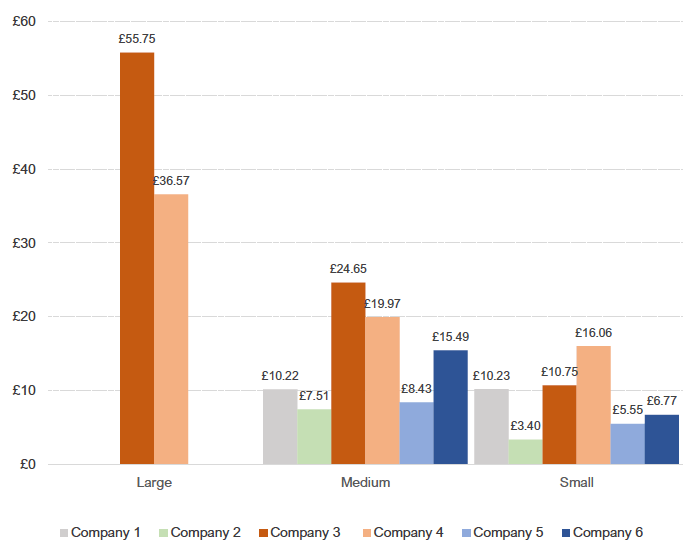
Prices also vary across delivery times and services. As Table 4 shows, standard deliveries and drop-off deliveries are consistently cheaper than next-day deliveries and door-to-door deliveries.
| Delivery time | ||||
|---|---|---|---|---|
| Standard service | Next-day service | |||
| Company name | Door-to-door | Shop drop-off | Door-to-door | Shop drop-off |
| Company 1 | £10.23 | |||
| Company 2 | £5.45 | |||
| Company 3 | £26.19 | £28.68 | £34.59 | £32.05 |
| Company 4 | £24.20 | |||
| Company 5 | £6.99 | £4.74 | £7.62 | |
| Company 6 | £5.99 | £11.49 | ||
Rurality and remoteness
The Scottish Government provides a standard definition of rural areas based on population size and distance from nearest settlement. These classifications vary in their level of detail, ranging from two-fold (urban and rural) to the most-detailed eight-fold categorisation. We include this estimate of rurality/proximity in our analysis to understand the different impacts these have on postal charges.
Three-fold rural–urban classification[38]
This classification assigns each postcode to one of the following categories:
- Rest of Scotland
- Accessible rural
- Remote rural
The detailed definition of each category is reported in Annex C.
Chart 3 and Table 5 show that while prices charged for accessible rural postcodes do not vary significantly from prices in the rest of Scotland, remote rural postcodes face much higher prices. More specifically, for large parcels, individuals in remote rural areas pay 17% higher for delivery, while the prices for medium and small parcels are 26% higher and 46% higher, respectively. The lowest probability of delivery availability rate is 83%, for medium parcels in remote and rural areas.[39]
| Rurality classification | Parcel size | Mean price | Average delivery availability probability |
|---|---|---|---|
| Rest of Scotland | Large | £50.29 | 100% |
| Medium | £17.21 | 98% | |
| Small | £8.03 | 99% | |
| Accessible rural | Large | £51.02 | 100% |
| Medium | £17.39 | 98% | |
| Small | £8.14 | 99% | |
| Remote rural | Large | £58.76 | 100% |
| Medium | £21.68 | 83% | |
| Small | £11.75 | 96% |
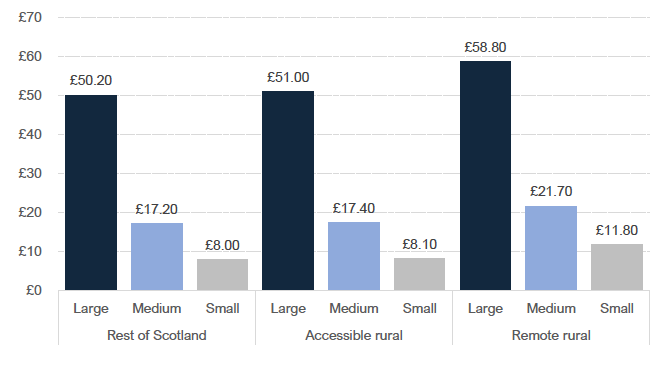
Table 6 and Chart 4 show average prices by delivery time and type of service. Interestingly, prices do not seem to vary significantly between areas, apart from next-day door-to-door delivery, which is 75% more expensive in remote rural Scotland than in the rest of the country.
| Type of delivery | |||||
|---|---|---|---|---|---|
| Door-to-door | Shop drop-off | ||||
| Rurality classification | Delivery time | Average price | Average delivery availability probability | Average price | Average delivery availability probability |
| Rest of Scotland | Standard | £19.70 | 99% | £14.52 | 98% |
| Next day | £20.04 | 99% | £32.06 | 100% | |
| Accessible rural | Standard | £19.34 | 99% | £14.41 | 99% |
| Next day | £21.21 | 99% | £32.06 | 100% | |
| Rural Scotland | Standard | £20.85 | 87% | £14.78 | 95% |
| Next day | £34.99 | 89% | £32.06 | 100% | |
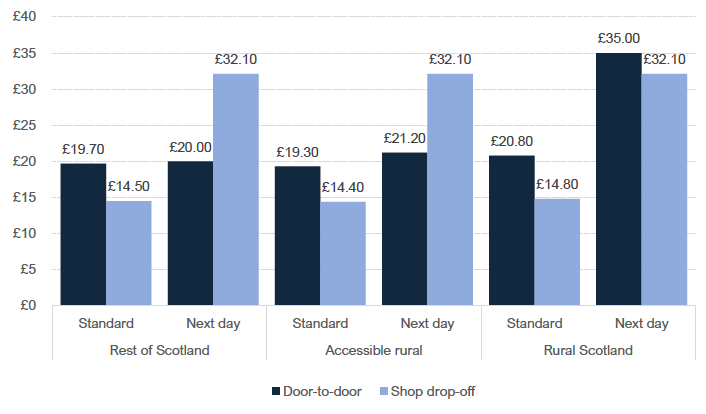
Eight-fold rural-urban classification[40]
This classification assigns each postcode to one of the following categories
- Large urban areas
- Other urban areas
- Accessible small towns
- Remote small towns
- Very remote small towns
- Accessible rural
- Remote rural
- Very remote rural
The detailed definition of each category is reported in Annex C.
Chart 5 and Table 7 show that postcodes in urban areas, accessible small towns and accessible rural areas face similar postal charges, with remote small towns and remote rural having slightly higher prices for larger parcels. On the other hand, very remote small towns and very remote rural areas are charged significantly higher prices, varying from 22% (large parcels) to 68% (small parcels) higher compared to large urban areas. The probability of delivery availability is higher than 90% everywhere apart from very remote small towns and very remote rural areas, where it is 79% for medium parcels. Out of the six postal operators in our sample, only two deliver large parcels, and thus the descriptive statistics are calculated based on only those two companies.
| Parcel size | ||||||
|---|---|---|---|---|---|---|
| Rurality classification | Large | Medium | Small | |||
| Average price | Average delivery availability probability | Average price | Average delivery availability probability | Average price | Average delivery availability probability | |
| Large Urban Areas | £49.79 | 100% | £16.84 | 99% | £7.75 | 99% |
| Other Urban Areas | £49.78 | 100% | £17.17 | 98% | £8.00 | 99% |
| Accessible Small Towns | £50.78 | 100% | £17.28 | 99% | £8.01 | 99% |
| Remote Small Towns | £53.26 | 100% | £18.15 | 95% | £8.55 | 97% |
| Very Remote Small Towns | £60.89 | 100% | £23.71 | 78% | £13.22 | 96% |
| Accessible Rural | £51.01 | 100% | £17.38 | 98% | £8.14 | 99% |
| Remote Rural | £55.77 | 100% | £19.40 | 91% | £9.78 | 98% |
| Very Remote Rural | £60.58 | 100% | £23.17 | 79% | £13.05 | 93% |
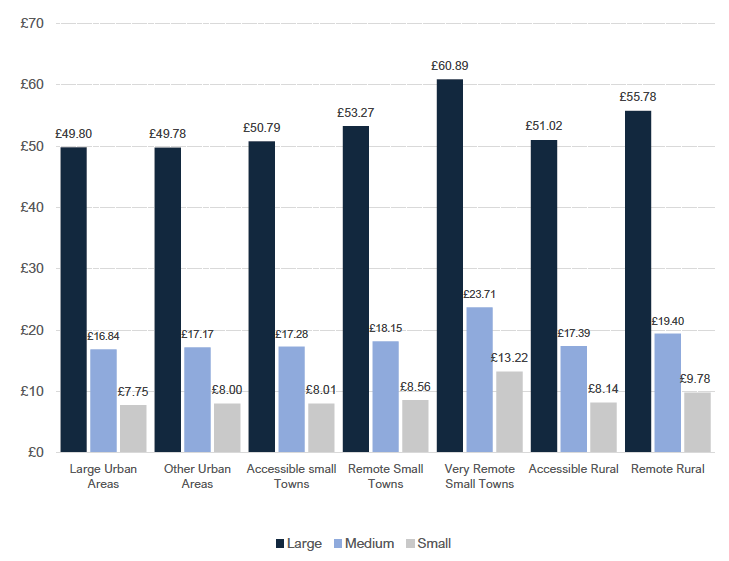
Table 8 shows that the differences in prices between very remote areas and the rest of Scotland is much more prominent for next-day door-to-door deliveries.
| Type of delivery | |||||
|---|---|---|---|---|---|
| Door-to-door | Shop drop-off | ||||
| Rurality classification | Delivery time | Average price | Average delivery availability probability | Average price | Average delivery availability probability |
| Large urban areas | Standard | £19.60 | 99% | £14.44 | 98% |
| Next day | £19.09 | 99% | £32.06 | 100% | |
| Other urban areas | Standard | £19.76 | 99% | £14.54 | 99% |
| Next day | £19.67 | 99% | £32.06 | 100% | |
| Accessible small towns | Standard | £19.61 | 87% | £14.47 | 95% |
| Next day | £20.53 | 89% | £32.06 | 100% | |
| Remote small towns | Standard | £19.08 | 97% | £14.92 | 93% |
| Next day | £23.78 | 98% | £32.06 | 100% | |
| Very remote small towns | Standard | £21.96 | 83% | £15.17 | 92% |
| Next day | £39.14 | 88% | £32.06 | 100% | |
| Accessible rural | Standard | £19.33 | 98% | £32.06 | 100% |
| Next day | £21.21 | 99% | £14.41 | 99% | |
| Remote rural | Standard | £19.53 | 93% | £32.06 | 100% |
| Next day | £28.45 | 95% | £14.51 | 97% | |
| Very remote rural | Standard | £21.71 | 84% | £14.96 | 93% |
| Next day | £39.34 | 86% | £32.00 | 100% | |
Islands
Scottish islands are anecdotally among the areas facing the greatest problems of surcharges and refusal to deliver. As Chart 6 and Table 9 show, prices are consistently higher in islands compared to the rest of Scotland, with small parcels being charged 64% higher than in other areas, and medium and large parcels 36% and 18% higher respectively. Probability to deliver is slightly lower in islands for small parcels, but 77% for medium parcels compared to 97% in the rest of Scotland.
| Geographic location | Parcel size | Average price | Average delivery availability probability |
|---|---|---|---|
| Not an island | Large | £51.30 | 100% |
| Medium | £17.63 | 97% | |
| Small | £8.36 | 99% | |
| Island | Large | £60.95 | 100% |
| Medium | £23.96 | 77% | |
| Small | £13.76 | 91% |
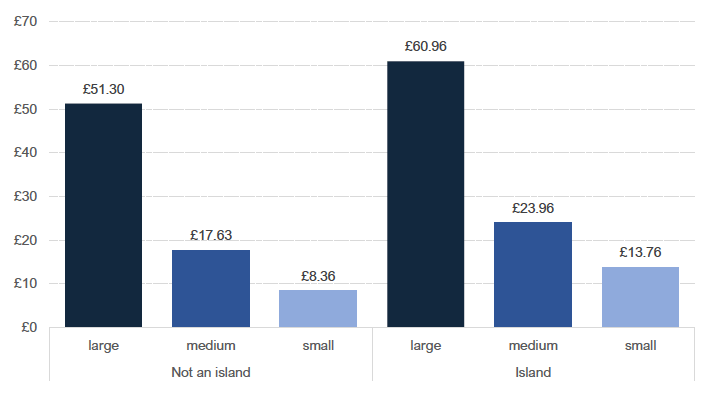
As Table 10 and Chart 7 show, the most prominent differences in price and delivery probability are for next-day door-to-door deliveries where the price for islands is almost double than in the rest of the country. The rest of the combinations of delivery times and types have much lower differences.
| Type of delivery | |||||
|---|---|---|---|---|---|
| Door-to-door | Shop drop-off | ||||
| Geographic location | Delivery time | Average price | Average delivery availability probability | Average price | Average delivery availability probability |
| Not an island | Standard | £19.67 | 97% | £14.51 | 98% |
| Next day | £21.53 | 99% | £32.06 | 100% | |
| Island | Standard | £22.56 | 83% | £15.26 | 90% |
| Next day | £41.27 | 83% | £31.96 | 100% | |
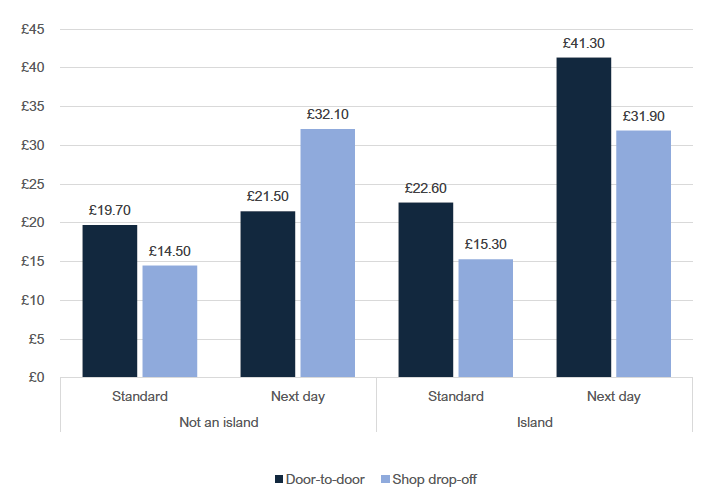
Regions
Our review of existing research and stakeholder interviews suggest that surcharges may be more common in the Highlands and Islands rather than other regions of Scotland. [41] Chart 8 and Table 11 show the price and probability to deliver variation across different regions in our data. The Highlands and Islands face the highest delivery prices on average among all regions and all parcel sizes and the lowest delivery probability (although still quite high). North Eastern Scotland has the second higher prices, while Eastern and South Western Scotland have the lowest average prices.
| Region | Average price | Average delivery availability probability | Average price | Average delivery availability probability | Average price | Average delivery availability probability |
|---|---|---|---|---|---|---|
| Eastern Scotland | £50.31 | 100% | £17.11 | 99% | £7.83 | 99% |
| Highlands and Islands | £60.25 | 100% | £22.77 | 80% | £12.74 | 94% |
| North Eastern Scotland | £54.90 | 100% | £17.28 | 100% | £8.08 | 100% |
| South Western Scotland | £48.57 | 100% | £16.78 | 99% | £7.72 | 99% |
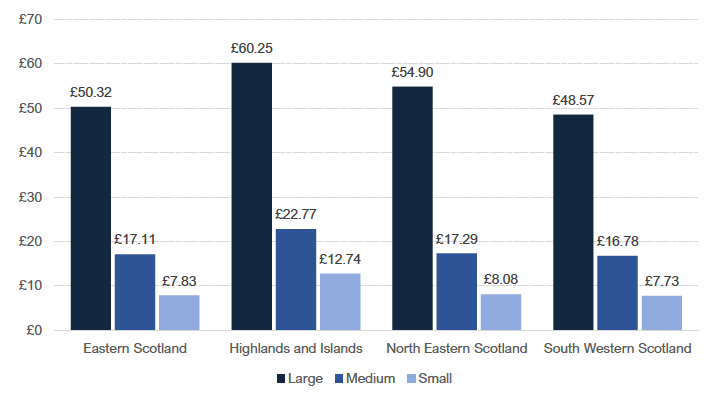
Consistent with all the previous results, Chart 9 and Table 12 show that the differences between the Highlands and Islands and other regions are much more prominent when the delivery is for next-day and door-to-door.
| Type of delivery | |||||
|---|---|---|---|---|---|
| Door-to-door | Shop drop-off | ||||
| Region | Delivery time | Average price | Average delivery availability probability | Average price | Average delivery availability probability |
| Eastern Scotland | Standard | £19.81 | 99% | £14.41 | 98% |
| Next day | £19.85 | 99% | £32.06 | 100% | |
| Highlands and islands | Standard | £21.21 | 85% | £15.05 | 92% |
| Next day | £38.18 | 87% | £32.03 | 100% | |
| North Eastern Scotland | Standard | £17.01 | 100% | £14.31 | 100% |
| Next day | £25.45 | 100% | £32.06 | 100% | |
| Western Scotland | Standard | £20.04 | 99% | £14.48 | 98% |
| Next day | £18.17 | 99% | £32.06 | 100% | |
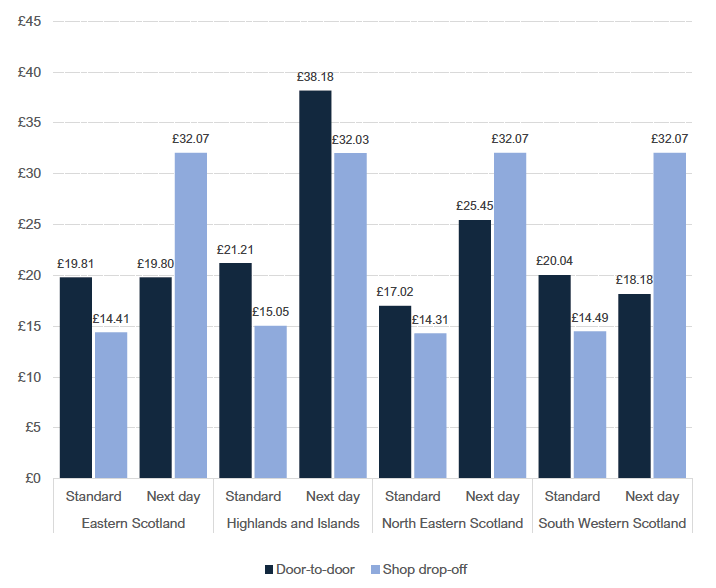
Council areas
Delivery companies may require surcharges on delivery for specific council areas within a region rather than a region as a whole; if a region has several council areas that are predominantly rural, they may face surcharges whereas urban council areas within the region may not. Tables 13, 14 and 15 show the price and probability to deliver variation across the 32 councils in Scotland by parcel size. The majority of council areas face similar postal charges, but the councils of Moray, Argyll and Bute, Highland, Na h-Eileanan Siar, Orkney Islands and Shetland Islands have significantly higher average prices than the rest of the country. For small parcels, Shetland Islands’ average price is 84% higher than the lowest average price in the country. For medium and large parcels, the difference is 46% and 28% respectively. The delivery probability is slightly lower in the areas mentioned above for small parcels, although still higher than 90%. However, for medium parcels the probability falls to 78%-80% in those councils. Out of the six postal operators in our sample, only two deliver large parcels, and thus the descriptive statistics are calculated based on only those two companies.
| Council Areas | Parcel size | Average price | Average delivery availability probability |
|---|---|---|---|
| Highland | Large | £60.93 | 100% |
| Na h-Eileanan Siar | Large | £60.89 | 100% |
| Orkney Islands | Large | £60.89 | 100% |
| Shetland Islands | Large | £60.89 | 100% |
| Argyll and Bute | Large | £59.54 | 100% |
| Moray | Large | £58.53 | 100% |
| Aberdeenshire | Large | £54.93 | 100% |
| Aberdeen City | Large | £54.86 | 100% |
| East Lothian | Large | £53.84 | 100% |
| Dumfries and Galloway | Large | £53.81 | 100% |
| Angus | Large | £53.62 | 100% |
| West Lothian | Large | £52.68 | 100% |
| City of Edinburgh | Large | £51.44 | 100% |
| Midlothian | Large | £51.24 | 100% |
| Stirling | Large | £51.24 | 100% |
| Dundee City | Large | £51.07 | 100% |
| Scottish Borders | Large | £48.87 | 100% |
| North Ayrshire | Large | £48.58 | 100% |
| Falkirk | Large | £48.19 | 100% |
| Fife | Large | £48.06 | 100% |
| Perth and Kinross | Large | £48.00 | 100% |
| Clackmannanshire | Large | £47.79 | 100% |
| East Ayrshire | Large | £47.79 | 100% |
| East Dunbartonshire | Large | £47.79 | 100% |
| East Renfrewshire | Large | £47.79 | 100% |
| Glasgow City | Large | £47.79 | 100% |
| Inverclyde | Large | £47.79 | 100% |
| North Lanarkshire | Large | £47.79 | 100% |
| Renfrewshire | Large | £47.79 | 100% |
| South Ayrshire | Large | £47.79 | 100% |
| South Lanarkshire | Large | £47.79 | 100% |
| West Dunbartonshire | Large | £47.79 | 100% |
| Council Areas | Parcel size | Average price | Average delivery availability probability |
|---|---|---|---|
| Na h-Eileanan Siar | Medium | £24.23 | 79% |
| Shetland Islands | Medium | £24.20 | 80% |
| Orkney Islands | Medium | £24.01 | 78% |
| Highland | Medium | £23.04 | 80% |
| Argyll and Bute | Medium | £22.87 | 78% |
| Moray | Medium | £20.24 | 88% |
| Stirling | Medium | £17.85 | 98% |
| Scottish Borders | Medium | £17.43 | 99% |
| Angus | Medium | £17.39 | 100% |
| Aberdeenshire | Medium | £17.30 | 100% |
| Aberdeen City | Medium | £17.27 | 100% |
| Dumfries and Galloway | Medium | £17.24 | 99% |
| East Lothian | Medium | £17.19 | 99% |
| West Lothian | Medium | £17.17 | 99% |
| Perth and Kinross | Medium | £17.16 | 98% |
| North Ayrshire | Medium | £17.05 | 98% |
| Midlothian | Medium | £17.04 | 100% |
| Dundee City | Medium | £17.00 | 100% |
| Fife | Medium | £16.97 | 100% |
| City of Edinburgh | Medium | £16.97 | 100% |
| Renfrewshire | Medium | £16.80 | 97% |
| East Renfrewshire | Medium | £16.77 | 98% |
| North Lanarkshire | Medium | £16.73 | 99% |
| Falkirk | Medium | £16.73 | 99% |
| South Lanarkshire | Medium | £16.71 | 100% |
| East Dunbartonshire | Medium | £16.66 | 99% |
| Glasgow City | Medium | £16.66 | 99% |
| Clackmannanshire | Medium | £16.61 | 100% |
| East Ayrshire | Medium | £16.61 | 100% |
| Inverclyde | Medium | £16.61 | 100% |
| South Ayrshire | Medium | £16.61 | 100% |
| West Dunbartonshire | Medium | £16.61 | 100% |
| Council Areas | Parcel size | Average price | Average delivery availability probability |
|---|---|---|---|
| Shetland Islands | Small | £14.07 | 95% |
| Orkney Islands | Small | £13.75 | 93% |
| Na h-Eileanan Siar | Small | £13.48 | 97% |
| Highland | Small | £13.08 | 94% |
| Argyll and Bute | Small | £12.75 | 93% |
| Moray | Small | £10.55 | 94% |
| Stirling | Small | £8.82 | 100% |
| Aberdeenshire | Small | £8.08 | 100% |
| Aberdeen City | Small | £8.08 | 100% |
| Angus | Small | £8.00 | 100% |
| North Ayrshire | Small | £7.98 | 99% |
| Dumfries and Galloway | Small | £7.82 | 99% |
| East Lothian | Small | £7.81 | 99% |
| Scottish Borders | Small | £7.80 | 99% |
| West Lothian | Small | £7.80 | 99% |
| Midlothian | Small | £7.78 | 100% |
| Dundee City | Small | £7.76 | 100% |
| City of Edinburgh | Small | £7.75 | 100% |
| Renfrewshire | Small | £7.74 | 96% |
| Fife | Small | £7.74 | 100% |
| Perth and Kinross | Small | £7.74 | 100% |
| East Renfrewshire | Small | £7.72 | 99% |
| North Lanarkshire | Small | £7.71 | 99% |
| Falkirk | Small | £7.70 | 100% |
| South Lanarkshire | Small | £7.69 | 100% |
| Glasgow City | Small | £7.68 | 100% |
| East Dunbartonshire | Small | £7.68 | 100% |
| Clackmannanshire | Small | £7.66 | 100% |
| East Ayrshire | Small | £7.66 | 100% |
| Inverclyde | Small | £7.66 | 100% |
| South Ayrshire | Small | £7.66 | 100% |
| West Dunbartonshire | Small | £7.66 | 100% |
The Highlands and Islands face the highest delivery prices on average among all regions and all parcel sizes and the lowest delivery probability (although still quite high). North Eastern Scotland has the second higher prices, while Eastern and South Western Scotland have the lowest average prices.
Econometric results
In this section we present the results from estimating Equation 1, which is presented in the Model specification section of this report. The main contribution of this analysis, in contrast to the descriptive statistics presented above, is that it shows the effect of regional characteristics, once the impact of parcel size, delivery type, speed and companies are removed.
We report results on delivery company postal charges for our two main specifications: the first controls for the Scottish Government eight-fold urban/rural classification (the most granular definition of rurality/remoteness available), and the second controls for specific council areas. As discussed earlier, for each specification we use a linear model controlling for delivery time, type of service, parcel size and the company doing the delivery.
Our full set of econometric results, including robustness checks that include island dummies, regions and the Scottish Government three-fold urban-rural classification, can be found in Annex D.
Rurality and remoteness
For this specification, we estimate the impact of levels of rurality and remoteness on price controlling for type of delivery (door-to-door or shop drop-off), delivery time (next-day or standard), parcel size (small, medium, large) and delivery companies. [42] Consequently, the results below can be interpreted as the effect of rurality and remoteness when all other factors are held constant.
We use large urban areas as our reference category – thus, the results reported below are in comparison with this category.[43] Population density was excluded in this regression, as this indicator is correlated with our detailed rural/urban indicators and including both would lead to inaccurate estimates of the impacts of rurality and remoteness.
According to the Scottish Government’s definitions, whether an area is considered urban or rural depends on the population of the settlements, while remoteness depends on the drive time to a settlement of 10,000 or more. The results presented on Table 16 show that whether an area is considered urban, small town, or rural does not affect significantly the delivery charges. However, when an area is remote or very remote, then the delivery prices are significantly higher than large urban areas ranging from five per cent, for remote small towns, to 23% for very remote small towns and rural areas. This suggests that remoteness, when defined by distance from settlements of 10,000 people or more, is a more important driver of surcharge than rurality on its own.
| Variable | Effect |
|---|---|
|
No significant difference from prices in large urban areas. |
|
Remote small towns face prices five per cent higher than large urban areas. |
|
Remote rural areas face prices nine per cent higher than large urban areas. |
|
Very remote small towns and very remote rural areas face prices 23% higher than large urban areas on average. |
One issue that frequently came up in the interviews is that the surcharge and refusal problems are more common among large parcels. We examined this by estimating the above regression separately for each parcel size. Chart 10 shows the different impacts of rurality by parcel size. The impact of rurality on price seemed to be more prominent for large parcels. Very remote rural areas and small towns are being charged 22% higher for small parcels but 26% higher than large urban areas for large parcels compared to large urban areas. Similarly, remote rural areas are being charged seven per cent higher prices for small parcels but 15% higher for large parcels compared to large urban areas. For remote small towns, the impact on prices increases from three per cent to 10%.
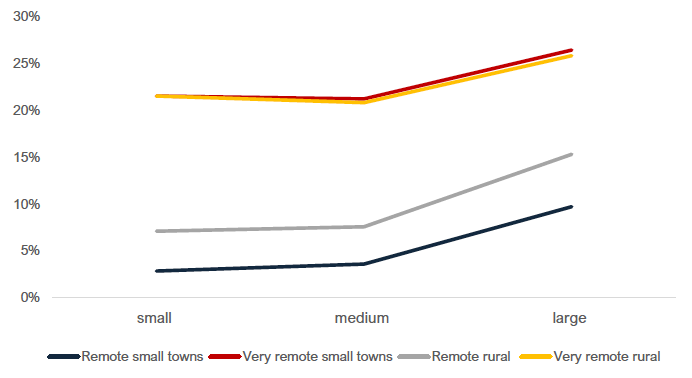
Council areas
For this specification, we estimate the impact of living in each council area in Scotland on prices controlling for rurality and remoteness of each sector postcode, for type of delivery (door-to-door or shop drop-off), delivery time (next-day or standard), parcel size (small, medium, large) and delivery company. [44] We used the Glasgow council area as our reference category – thus, all results reported below directly compare postal charges in Glasgow to postal charges in each respective council area.
Table 17 provides evidence that surcharges seem to be concentrated in specific councils located in Highlands and Islands and North Eastern Scotland. In particular, living in Argyll and Bute, Highland, Orkney Islands, Na h-Eileanan Siar and Shetland Islands is associated with a surcharge of at least 19%.
An interesting result is that when controlling for both the council areas and the remoteness and rurality of a specific postcode sector, the impact of being in a very remote postcode sector drops from 23% (as shown in Table 16) to only six per cent (as shown in Table 17).[45] In other words, the impact of rurality or remoteness of a postcode sector is less important than the house’s wider council, if someone lives in one of the council areas being affected by surcharging. This is an indication that delivery companies’ pricing methods do not account as much for small area characteristics as the location of council areas.
| Variable | Effect |
|---|---|
| Perth and Kinross, East Ayrshire, South Ayrshire, Clackmannanshire, South Lanarkshire, East Renfrewshire, Fife, East Dunbartonshire, West Dunbartonshire, North Lanarkshire, Scottish Borders, Inverclyde, Falkirk, Renfrewshire, North Ayrshire | No significant difference than Glasgow |
| Dundee City, City of Edinburgh | Three per cent higher prices than Glasgow |
| Midlothian, West Lothian | Four per cent higher prices than Glasgow |
| Dumfries and Galloway, East Lothian, Stirling | Five per cent higher prices than Glasgow |
| Angus | Six per cent higher prices than Glasgow |
| Aberdeen City, Aberdeenshire | Seven per cent higher prices than Glasgow |
| Moray | 16% higher prices than Glasgow |
| Argyll and Bute | 19% higher prices than Glasgow |
| Highland | 20% higher prices than Glasgow |
| Orkney Islands | 22% higher prices than Glasgow |
| Na h-Eileanan Siar | 23% higher prices than Glasgow |
| Shetland Islands | 26% higher prices than Glasgow |
For robustness, we estimated an additional specification where rurality and remoteness indicators were removed, and population density was added in the model.[46] The estimated impact of council areas on price did not change much, with the coefficients of the areas with the highest surcharges, namely, Argyll and Bute, Highland, Orkney Islands, Na h-Eileanan Siar and Shetland Islands, being increased but by only two-four per cent. The results of this estimation are presented on Map 1.
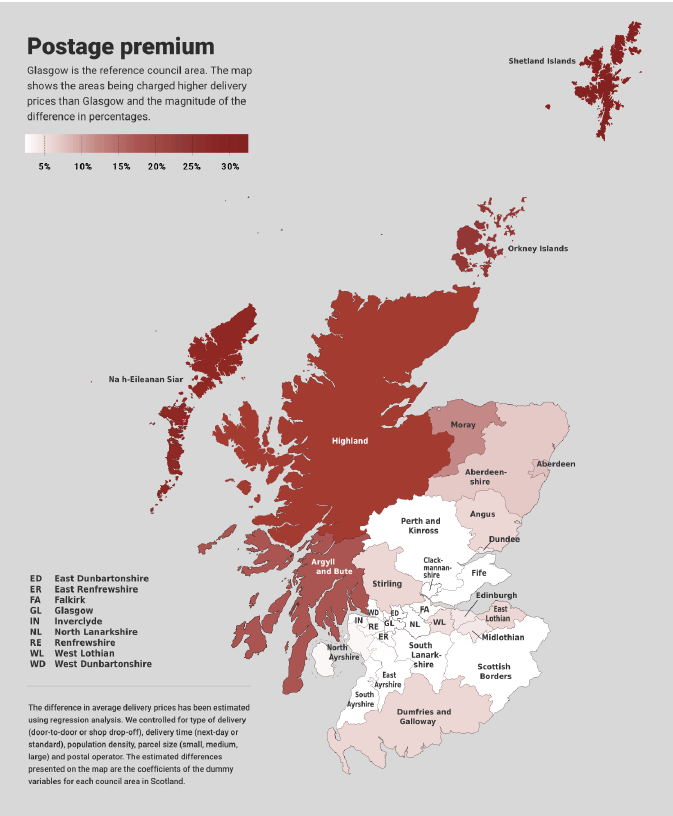
Comparing predicted and actual postal charges
Identifying precisely what constitutes an “unfair” versus “fair” postal charge is a challenging question, as definitions of fairness vary dramatically across consumers, delivery companies and policymakers. Due to the more remote nature of the Highlands and Islands and other areas of rural Scotland, any deliveries made to these areas require additional fuel, labour and maintenance costs, and this makes it difficult for delivery companies to charge uniform prices across the entirety of Scotland.
One possible approach to identifying which postcodes face postal charges that could be deemed unfair is using our linear model estimated by OLS to predict postal charges based on underlying geographic and parcel characteristics. Our model allows us to estimate the relative impact of each of these characteristics and the resulting postal charge. Thus, for any given postcode, we can multiply the coefficient on each of our control variables by the given values for geographic and parcel characteristics to calculate a predicted postal charge. By calculating predicted values for all postcodes in our dataset, taking into account parcel size, speed of delivery, rurality and remoteness (as a proxy for fuel/driver costs) and differences in delivery companies, we can identify which postcodes face postal charges that could be deemed unfair, as these postcodes would have the greatest difference between actual postal charges and postal charges predicted by our model.
It is important to note that significant differences between actual postal charges and postal charges predicted by our model do not provide conclusive evidence that a specific postal charge is unfair. Our model does not capture all relevant characteristics that delivery companies must consider when pricing the cost of delivery – as discussed earlier, we do not directly account for fuel or labour costs, and remoteness and rurality are imperfect proxies for these. In addition, the different business models and logistics operations organised by each of the delivery companies in our dataset may cause some characteristics to be weighted more heavily than others (for example, the presence of a large number of smaller storage and sorting facilities may decrease the cost of delivery, but increase overhead and labour expenses). Since we do not have access to direct cost data, we cannot take into account these characteristics as well. Our model estimates provide one perspective on unfair postal charges that do not form a complete picture in and of themselves.
For small parcels on door-to-door, standard deliveries, there are large differences between actual and predicted postal charges. The ZE postcode area has a 51% difference, followed by HS (26%), AB (22%), DD (21%) and G (19%). These differences are much greater for next-day delivery options: the IV postcode area has the greatest difference at 158%, with KW, ZE and HS at 128% and PA and PH at 64% and 60%, respectively.
Postcode surcharges tend to be quite small for medium parcels on door-to-door, standard: the ZE postcode area has the greatest difference between actual and predicted postal charges at eight per cent, with G, EH, ML and KY facing surcharges of around one-two per cent.[47] However, similarly to small parcels if individuals would like to request next-day delivery of medium parcels they face significantly higher surcharges: the IV postcode area is penalised the most with a 64% difference between actual and predicted postal charges, followed by KW, ZE and HS at 46% and PA and PH at 19%.
In general, this analysis provides additional evidence that excessive charging exists for postcodes in more rural areas of Scotland, in particular for next-day deliveries.
| Postcode Area | Parcel Size | Delivery speed | Surcharge[49] |
|---|---|---|---|
| HS | Small | Standard | 26% |
| Next-day | 129% | ||
| Medium | Standard | -3% | |
| Next-day | 46% | ||
| IV | Small | Standard | 11% |
| Next-day | 158% | ||
| Medium | Standard | -8% | |
| Next-day | 64% | ||
| KW | Small | Standard | 5% |
| Next-day | 129% | ||
| Medium | Standard | -15% | |
| Next-day | 46% | ||
| PA | Small | Standard | 18% |
| Next-day | 65% | ||
| Medium | Standard | -4% | |
| Next-day | 20% | ||
| PH | Small | Standard | 12% |
| Next-day | 60% | ||
| Medium | Standard | -6% | |
| Next-day | 18% | ||
| ZE | Small | Standard | 51% |
| Next-day | 129% | ||
| Medium | Standard | 8% | |
| Next-day | 46% |
Areas affected by excessive surcharges
As explained above, our model provides an indicative estimate of the prevalence and location of excessive delivery charges. This section provides an insight on where these charges are more prevalent and how many areas and people are affected.
As there are many different combinations between delivery speed, delivery type and parcel size, we present an illustrative example of one combination.
Example: Next-day, door-to-door delivery of small parcels
The difference between predicted and actual delivery prices is close to zero for the majority of postcodes, but quite large and positive for a relatively small number of them. More specifically, there are 188 postcodes in Scotland that face prices that are higher than the price our model predicts by 75% or more. This corresponds to 18% of the 1,029 postcode sectors in our dataset, with a combined population of approximately 440,000 people – just over eight per cent of the population as recorded in the 2011 census.
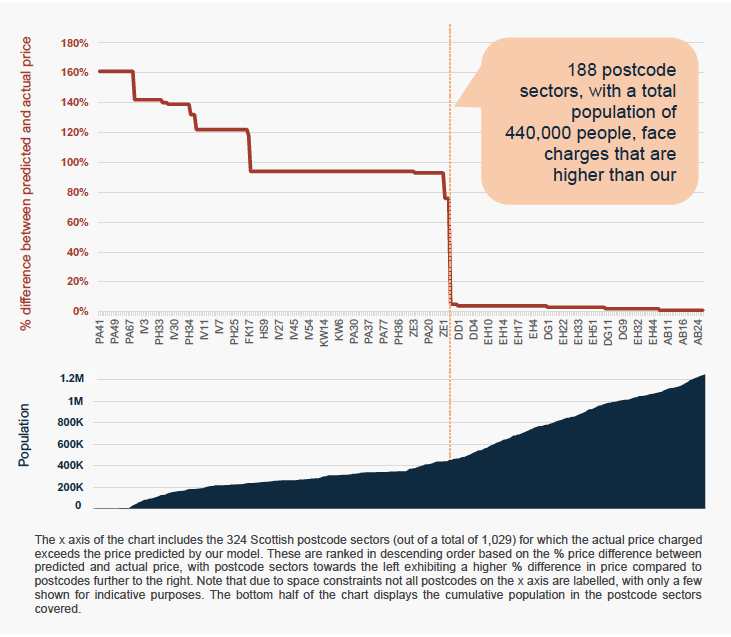
As Chart 12 shows, out of these 188 postcode sectors, 60% are classified as “very remote rural” with a further 15% classified as “remote rural”.
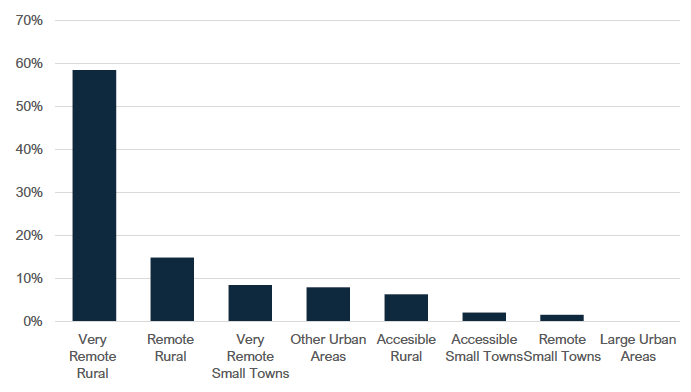
Chart 13 shows that almost every postcode sector in Scotland classified as ‘very remote small towns’ (16 out of 16) and ‘very remote rural’ (110 out of 115) faces prices that are 50% or higher than our model’s prediction.
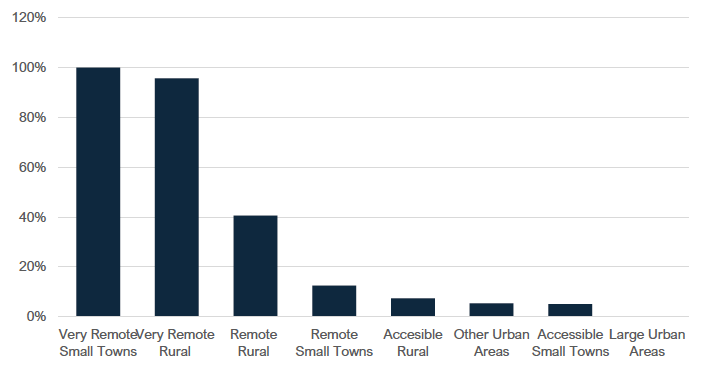
Other combinations of delivery service and parcel characteristics
Another common combination used by consumers and retailers is the next-day, door-to-door delivery of medium parcels. 79 postcode sectors face prices that are higher by 50% or more compared to our model’s prediction, together accounting for eight per cent of all postcode sectors in Scotland and corresponding to approximately 227,000 people (4.3% of the country’s population). 58% of those postcodes are either remote or very remote rural areas – for reference, across Scotland only about 18% of all postcode sectors are classified as being in “remote” or “very remote” rural areas.
Standard service had lower prevalence and levels of differences between the actual and predicted prices. More specifically, for standard service small parcels the maximum price difference was 38%, and disadvantaged postcodes included many urban and accessible areas rather than being solely concentrated on rural and remote areas.
Overall, next-day delivery options exhibited the highest gap between actual prices and those predicted by our model, with most of the areas affected being remote and rural. Excessive charges associated to standard service affect a smaller share of the Scottish population, including many in urban and accessible areas.
Retailers
The retailers in our dataset charge identical shipping fees for delivery addresses in all postcodes, irrespective of location. However, for certain postcodes not all retailers allowed us to order products online, either indicating that delivery was not available or first requiring a phone call to a customer service number to discuss specific options. Thus, our variable of interest is the probability that retailers provide home delivery to a specific postcode. This is modelled as a binary variable: 1 if a retailer provides home delivery to a specific postcode and 0 if not. We use a linear probability model to estimate the marginal impact of population density, type of product and geographical characteristics on a retailer’s decision to provide home delivery.
Descriptive statistics
This section presents the average probability of home delivery availability in different areas and by different retailers. The averages discussed below represent the retailers within our sample.
Variation across retailers
There is significant variation across retailers in their willingness to provide home delivery options, ranging from 66% to 95% (Chart 11).
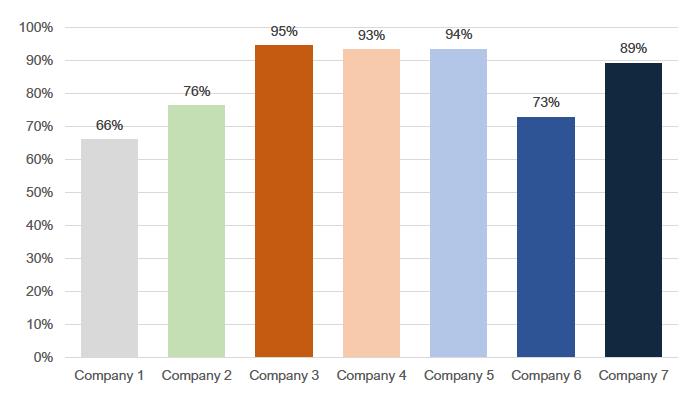
As can be seen from Chart 12, the three products in our dataset all require large packages, but retailers’ ability to deliver differ across all three, with the 43-inch TV the most likely at 91.5% and 3-piece saucepan set the least likely at 72.9%.
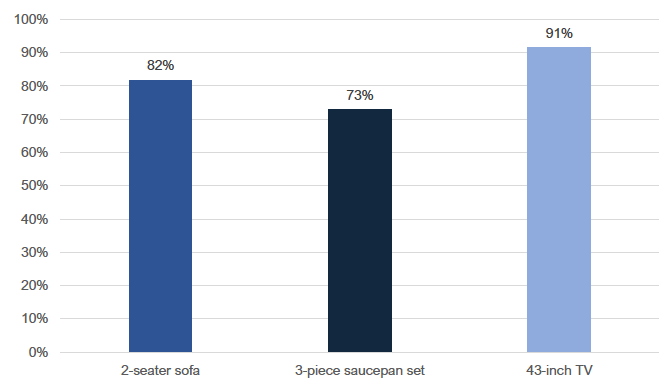
Rurality and remoteness
Three-fold classification
Chart 13 shows that individuals who live in accessible rural areas are nearly as likely to have home delivery as an option when ordering from retailers as the rest of Scotland (88% compared to 92%). However, many who live in remote rural areas do not have this option, as the probability of home delivery availability is just 43%, less than half the probability for the rest of Scotland.
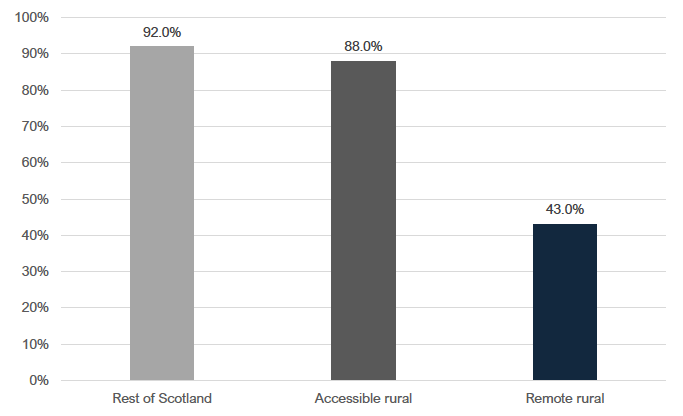
Eight-fold classification
Chart 14 shows that urban areas and accessible small towns/rural areas largely have access to home delivery from online retailers, with each having a probability of just under 90% or higher. However, the probability of home delivery is less than 75% for remote small towns/rural areas and is significantly lower for very remote areas, falling to 26% for very remote rural areas.
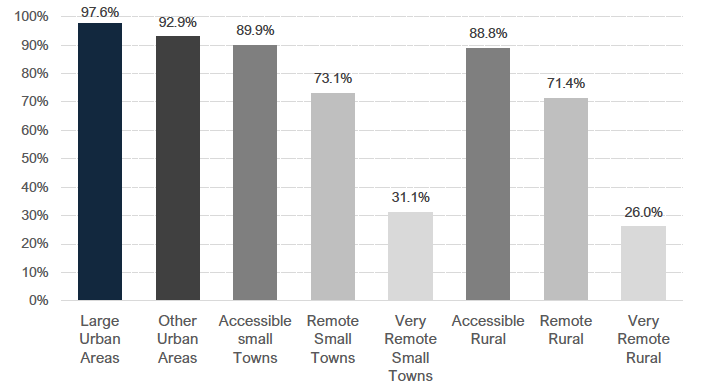
Islands
Home delivery is largely non-existent for postcodes located on islands, with the probability of availability less than 4% (compared to 88% for the Scottish mainland).
Regions
The probability of home delivery availability is largely similar across postcode sectors in Eastern, North Eastern and South Western Scotland, at around 90% or higher.
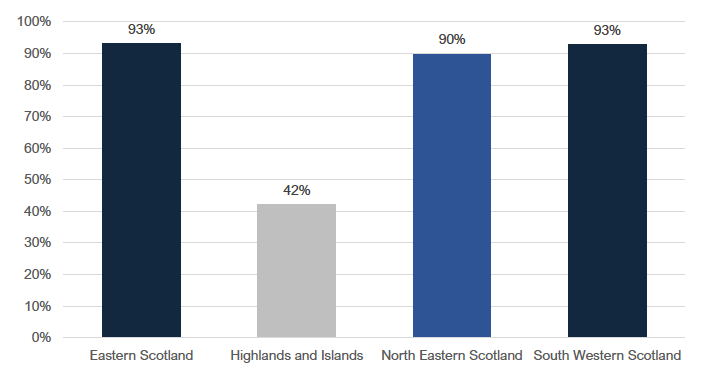
Council areas
The majority of council areas have at least an 85% probability of home delivery availability from online retailers. However, home delivery is significantly less common in regions in the Highlands and Islands: the Highland council area has a 52% probability of home delivery availability, with Argyll and Bute at 29% probability. Home delivery is highly uncommon to the islands, as the probability of home delivery availability is three per cent for Na h-Eileanan Siar and no retailers included in our dataset will deliver to the Orkney or Shetland Islands.
| Council area | Average delivery availability probability |
|---|---|
| Aberdeen City | 99% |
| Falkirk | 99% |
| Glasgow City | 99% |
| East Dunbartonshire | 99% |
| West Dunbartonshire | 98% |
| Dundee City | 98% |
| South Lanarkshire | 98% |
| Midlothian | 97% |
| East Ayrshire | 97% |
| Fife | 96% |
| East Renfrewshire | 96% |
| City of Edinburgh | 95% |
| West Lothian | 95% |
| Renfrewshire | 94% |
| Inverclyde | 94% |
| North Lanarkshire | 93% |
| South Ayrshire | 93% |
| Clackmannanshire | 93% |
| Angus | 93% |
| Stirling | 92% |
| North Ayrshire | 90% |
| Perth and Kinross | 88% |
| East Lothian | 85% |
| Scottish Borders | 85% |
| Aberdeenshire | 84% |
| Moray | 73% |
| Dumfries and Galloway | 62% |
| Highland | 52% |
| Argyll and Bute | 29% |
| Na h-Eileanan Siar | 3% |
| Orkney Islands | 0% |
| Shetland Islands | 0% |
Econometric results
In this section we present the results from estimating Equation 2, which is presented in the Model specification section of this report. The purpose of this analysis is to estimate the impact of different area characteristics on the probability of home delivery availability from online retailers. The main contribution of this analysis, as compared to the descriptive statistics presented above, is that it shows the effect of the variables of interest, once the effects of parcel size, delivery type and time and specific retailers are removed.
We report results on probability of home delivery availability from online retailers for our two main specifications: the first controls for the Scottish Government eight-fold urban/rural classification (the most granular definition of rurality/remoteness available), and the second controls for specific council areas. As discussed earlier, for each specification we use a linear probability model.
Our full set of econometric results, including robustness checks that include island dummies, regions and the Scottish Government three-fold urban-rural classification, can be found in Annex D.
Rurality and remoteness
For this specification, we estimate the impact of levels of rurality and remoteness on the probability of home delivery availability controlling for type of delivery (door-to-door or shop drop-off), delivery time (next-day or standard), parcel size (small, medium, large) and delivery companies.[50] Consequently, the results below can be interpreted as the effect of rurality and remoteness with all other variables held constant.
As with delivery companies we use large urban areas as our reference category – thus, the results reported below are in comparison with this category. Population density was excluded in this regression, as this indicator is correlated with our detailed rural/urban indicators.[51]
The results below indicate that individuals living in remote areas, either small towns or rural areas generally do not have the option of home delivery when ordering from online retailers. Postcodes in very remote small towns are 24% less likely to have home delivery available for retail products, while this percentage is 26% for very remote rural areas. The probability of home delivery availability is even smaller for very remote small towns (66% less likely) and rural areas (71%).
| Other urban areas | Other urban areas are four per cent less likely to have home delivery available for retail products. |
|---|---|
| Accessible small towns | Accessible small towns are seven per cent less likely to have home delivery available for retail products. |
| Remote small towns | Remote small towns are 24% less likely to have home delivery available for retail products. |
| Very remote small towns | Very remote small towns are 66% less likely to have home delivery available for retail products. |
| Accessible rural areas | Accessible rural areas are eight per cent less likely to have home delivery available for retail products. |
| Remote rural areas | Remote rural areas are 26% less likely to have home delivery available for retail products. |
| Very remote rural areas | Very remote rural areas are 71% less likely to have home delivery available for retail products. |
Council areas
For this specification, we estimate the impact of living in each council area in Scotland on probability of delivery availability on population density of sector postcodes, delivery prices, controlling for type of delivery (door-to-door or shop drop-off), delivery time (next-day or standard), parcel size (small, medium, large) and delivery companies. As with delivery companies, we used the Glasgow council area as our reference category.[52]
Absence of home delivery availability generally seems to be concentrated in specific councils primarily located in Highlands and Islands. In particular, living in Argyll and Bute, Highland, Orkney Islands, Na h-Eileanan Siar and Shetland Islands is associated with at least a 45% decrease in probability of home delivery availability.
| Variable | Effect |
|---|---|
| Aberdeen City, Clackmannanshire, East Ayrshire, East Dunbartonshire, East Renfrewshire, Falkirk, Fife, Inverclyde, Midlothian, Renfrewshire, South Ayrshire, South Lanarkshire, West Dunbartonshire, West Lothian | No significant difference than Glasgow |
| City of Edinburgh | Three per cent less likely for home delivery to be available |
| North Lanarkshire | Four per cent less likely for home delivery to be available |
| Angus, Stirling | Six per cent less likely for home delivery to be available |
| North Ayrshire | Seven per cent less likely for home delivery to be available |
| Perth and Kinross | 11% less likely for home delivery to be available |
| Aberdeenshire | 13% less likely for home delivery to be available |
| East Lothian, Scottish Borders | 14% less likely for home delivery to be available |
| Moray | 24% less likely for home delivery to be available |
| Dumfries and Galloway | 37% less likely for home delivery to be available |
| Highland | 46% less likely for home delivery to be available |
| Argyll and Bute | 70% less likely for home delivery to be available |
| Na h-Eileanan Siar | 94% less likely for home delivery to be available |
| Orkney Islands | 97% less likely for home delivery to be available |
| Shetland Islands | 99% less likely for home delivery to be available |
Contact
There is a problem
Thanks for your feedback